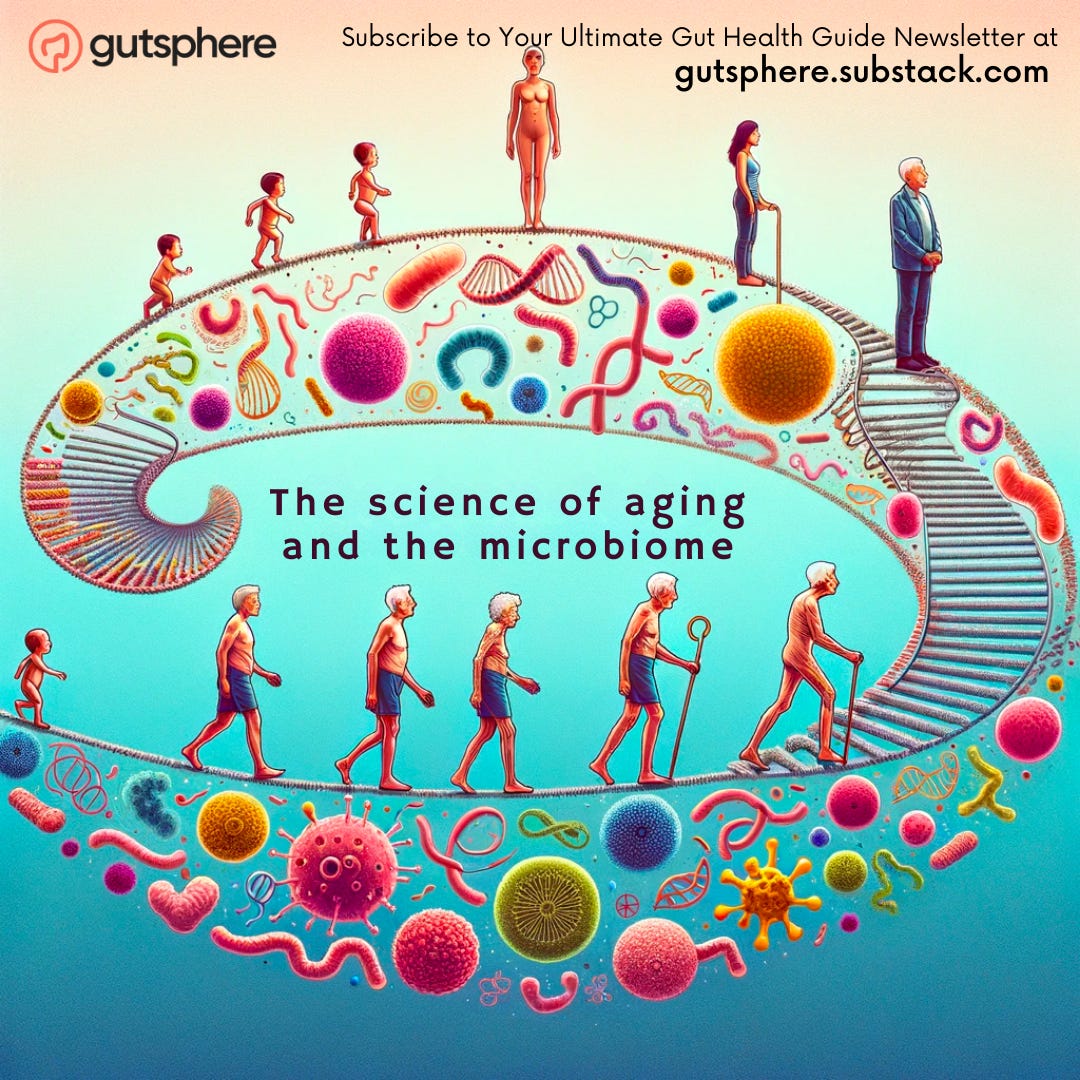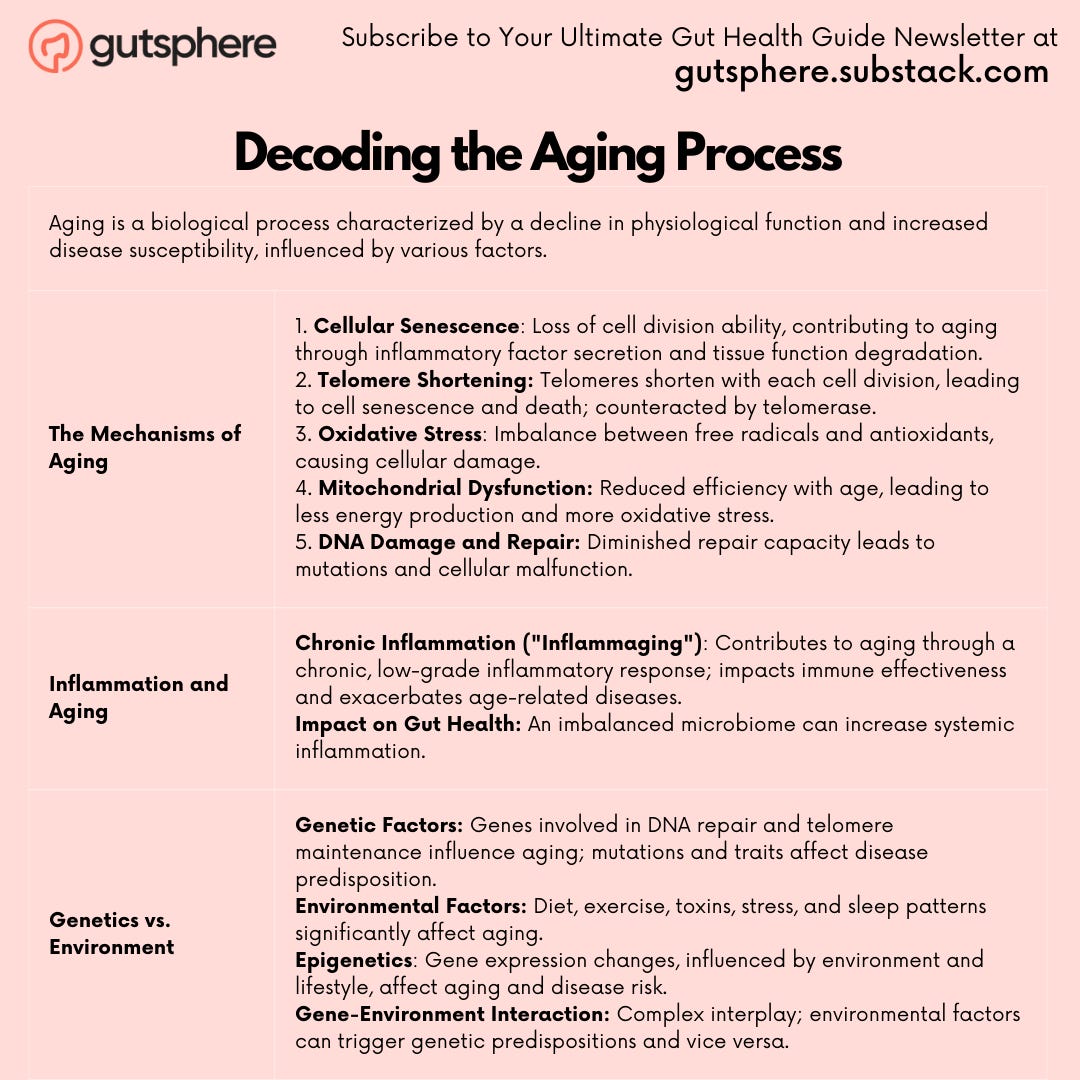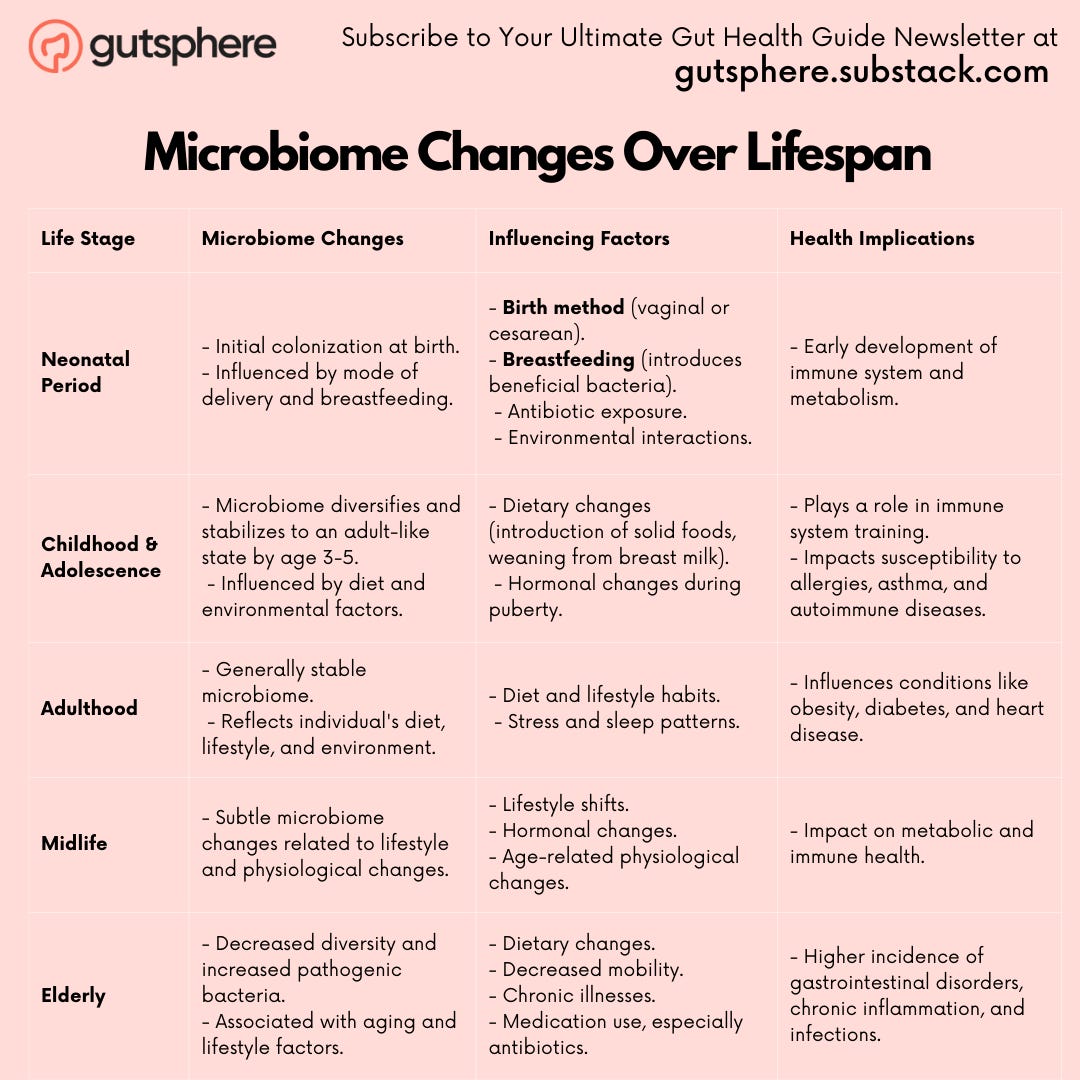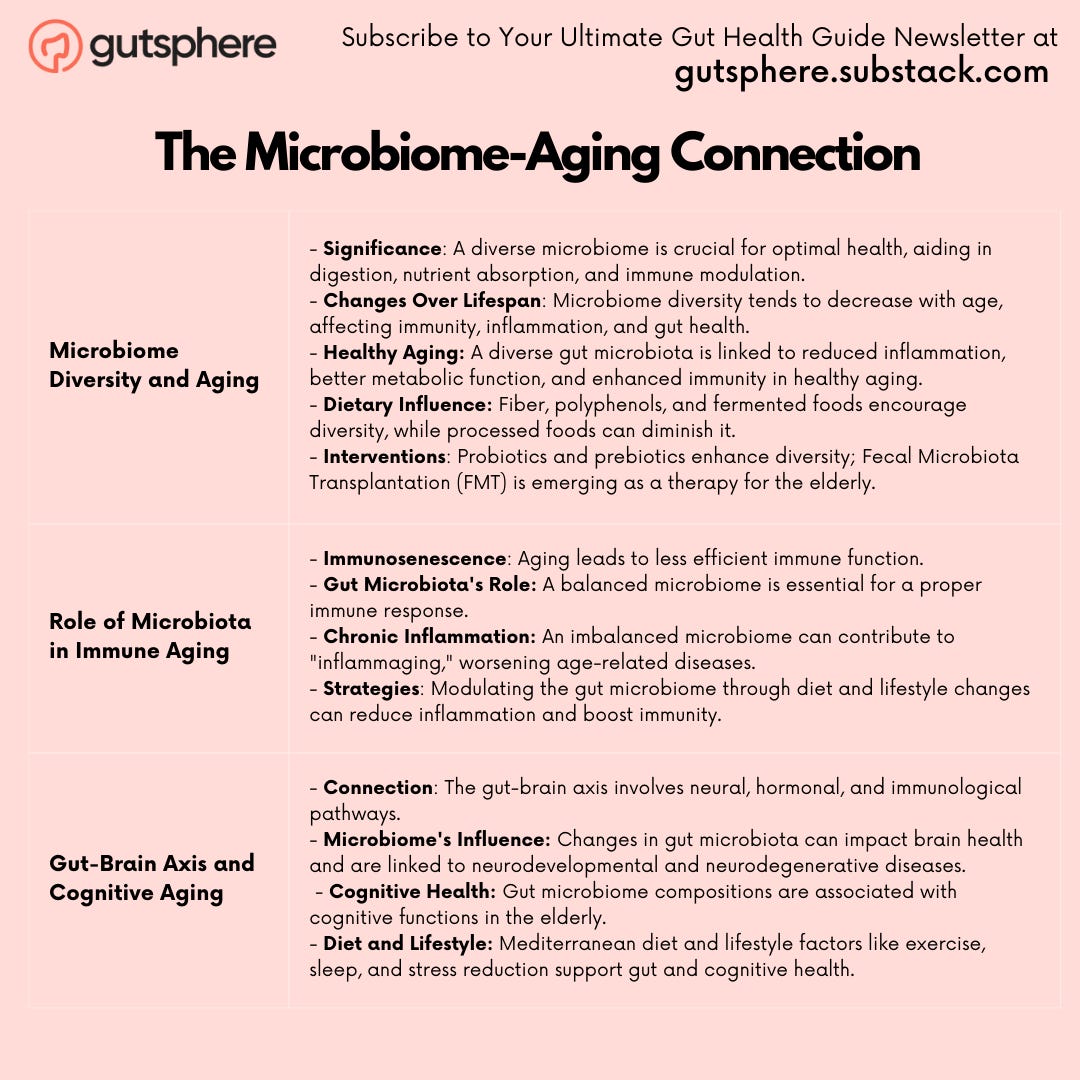The Science of Aging and the Microbiome ( Part 2/11)
Ageless Wisdom: Unveiling the Microbiome's Role in the Art of Aging
Hello, Everyone!
Welcome to the second installment of our series, "Forever Young: Unlocking the Gut's Power for Lifespan and Healthspan." Today, we're zooming in on a fascinating topic: The Science of Aging and the Microbiome. Drawing from the insights from a book "Lifespan: Why We Age – and Why We Don't Have To" and research paper, "Healthy Aging and the Human Gut Microbiome," we're set to uncover some groundbreaking revelations.
Decoding the Aging Process
Aging, an inevitable biological process, is characterized by a gradual decline in physiological function and increased susceptibility to diseases. While it's a universal experience, the rate and manner in which we age are influenced by a complex interplay of various factors. This chapter delves into the biological and physiological aspects of aging, shedding light on cellular and molecular processes, the role of inflammation, and the impact of genetics and environment.
The Mechanisms of Aging
Aging is not merely a passage of time but a biological process driven by intricate cellular and molecular events. At its core, aging can be understood through several key mechanisms:
Cellular Senescence: Cellular senescence refers to a state where cells lose their ability to divide. While initially a defense mechanism against cancer, over time, these senescent cells accumulate, contributing to aging by secreting inflammatory factors and degrading tissue function.
Telomere Shortening: Telomeres, protective caps at the ends of chromosomes, shorten with each cell division. Shortened telomeres trigger cell senescence and apoptosis (cell death), contributing to aging. This process is counteracted by the enzyme telomerase, but its activity decreases with age.
Oxidative Stress: Oxidative stress occurs when there's an imbalance between free radicals (unstable molecules that can damage cells) and antioxidants in the body. This imbalance leads to cellular damage, a key contributor to aging and age-related diseases.
Mitochondrial Dysfunction: Mitochondria, the powerhouses of cells, become less efficient with age. This inefficiency leads to reduced energy production and increased oxidative stress, further contributing to the aging process.
DNA Damage and Repair Mechanisms: As we age, the body's ability to repair DNA damage diminishes, leading to genetic mutations and cellular malfunction. This accumulation of DNA damage is a significant driver of aging.
Inflammation and Aging
Chronic inflammation plays a pivotal role in the aging process and is often referred to as "inflammaging." Unlike acute inflammation, which is a necessary part of the body's defense mechanism, chronic inflammation can have detrimental effects:
Immune System Response: With age, the immune system becomes less effective, a condition known as immunosenescence. This weakened state leads to a chronic, low-grade inflammatory response, damaging cells and tissues.
Impact on Chronic Diseases: Chronic inflammation is a common factor in many age-related diseases, such as arthritis, diabetes, heart disease, and Alzheimer's disease. The persistent inflammatory state exacerbates these conditions, accelerating the aging process.
Gut Health and Inflammation: The gut microbiome's health significantly influences systemic inflammation. An imbalanced gut microbiome can contribute to increased intestinal permeability, allowing inflammatory substances to enter the bloodstream.
Genetics vs. Environment
The aging process is influenced by both genetic predispositions and environmental factors, each playing a crucial role in determining how we age:
Genetic Factors: Genetics play a significant role in aging. Certain genes, like those involved in DNA repair and telomere maintenance, directly influence lifespan and the aging process. Genetic mutations and inherited traits can predispose individuals to age-related diseases.
Environmental Factors: Lifestyle and environmental factors significantly impact the aging process. Diet, exercise, exposure to toxins, stress, and sleep patterns all contribute to how we age. For example, a diet high in antioxidants can mitigate oxidative stress, while regular exercise can improve mitochondrial function.
Epigenetics: Epigenetics, changes in gene expression not caused by alterations in the DNA sequence, bridge the gap between genetics and environment. Epigenetic changes can be influenced by environmental factors and lifestyle choices, impacting aging and the risk of age-related diseases.
The Interaction of Genes and Environment: The interplay between genetics and environment is complex. Environmental factors can trigger genetic predispositions, while genetic factors can influence how one responds to environmental stimuli. This interaction is crucial in understanding individual variations in the aging process.
Microbiome Changes Over Lifespan
The human gut microbiome, a complex ecosystem of microorganisms, plays a critical role in our health. Its composition and function evolve throughout our lifetime, influencing and reflecting our overall well-being at each stage. This chapter explores the dynamic changes the microbiome undergoes from birth to old age, highlighting the factors influencing these changes and their implications on health.
The Neonatal Period: Establishing the Gut Microbiome
Initial Colonization:
Birth and Early Development: The microbiome begins to develop at birth. The mode of delivery (vaginal birth vs. cesarean section) significantly influences the initial microbial composition. Vaginal delivery exposes the infant to maternal vaginal and intestinal flora, while cesarean delivery results in a microbiome more similar to skin flora.
Breastfeeding and Microbial Development: Breastfeeding further shapes the infant's microbiome. Breast milk contains human milk oligosaccharides, which are indigestible by the infant but serve as prebiotics for certain beneficial gut bacteria, like Bifidobacteria.
Factors Influencing Early Microbiome Composition:
Antibiotic Exposure: Antibiotic use during infancy can disrupt the developing microbiome, potentially leading to long-term consequences on the child's immune system and metabolism.
Environmental Interactions: Exposure to various environments and caregivers also contributes to microbial diversity during early life.
Childhood and Adolescence: Microbiome Maturation
Diversification and Stabilization:
Dietary Changes: As children grow and diversify their diet, their microbiome becomes more complex, resembling an adult-like microbiome by age 3 to 5 years. The introduction of solid foods and eventual weaning from breast milk are pivotal in this maturation process.
Gut-Immune System Interactions: During this period, the microbiome plays a vital role in training and modulating the immune system, impacting the child's susceptibility to allergies, asthma, and autoimmune diseases.
Adolescence:
Hormonal Changes: The hormonal shifts during puberty can also influence the gut microbiome. These changes, along with diet and lifestyle factors typical of adolescence, can impact the microbiome's composition and function.
Adulthood: The Microbiome in Stability and Transition
The Prime of Microbial Diversity:
Diet and Lifestyle: In adulthood, the microbiome generally remains relatively stable, reflecting an individual's diet, lifestyle, and environment. Dietary habits, exercise, stress, and sleep patterns significantly influence the microbiome's diversity and functionality.
Microbial Signatures and Health: The adult microbiome has unique signatures that can be linked to various health conditions like obesity, diabetes, and heart disease. Maintaining a diverse and balanced microbiome is key to metabolic and immune health.
Midlife Changes:
Age-Related Shifts: As individuals progress through adulthood, subtle changes in the microbiome occur. These changes are often related to lifestyle shifts, hormonal changes, and the gradual onset of age-related physiological changes.
Elderly: The Microbiome in the Later Years
Decline in Diversity:
Aging and Microbial Shifts: In older adults, the microbiome often shows decreased diversity and an increased prevalence of pathogenic bacteria. This shift is associated with several factors, including dietary changes, decreased mobility, chronic illnesses, and increased medication use, especially antibiotics.
Impact on Health: These microbial changes in the elderly are linked to a higher incidence of gastrointestinal disorders, chronic inflammation, reduced immune function, and a susceptibility to infections.
The human gut microbiome undergoes significant changes throughout our lifespan, each stage reflecting and influencing our health status. From the initial colonization in infancy to the shifts in old age, understanding and nurturing our microbiome can offer avenues for improved health across all life stages. By recognizing the factors that impact these microbial changes, we can better support our microbiome for optimal health throughout our lives.
The Microbiome-Aging Connection
The intricate connection between the gut microbiome and the aging process represents a frontier in understanding human longevity and healthspan. This chapter explores how changes in the gut microbiome affect aging, focusing on microbiome diversity, its impact on the immune system, and the gut-brain axis related to cognitive aging.
Microbiome Diversity and Aging
The Significance of a Diverse Gut Microbiota:
Foundations of Microbial Diversity: A diverse gut microbiome, comprising various bacteria, fungi, viruses, and other microorganisms, is crucial for optimal health. It aids in digestion, nutrient absorption, and the synthesis of essential vitamins, and plays a pivotal role in modulating the immune system and inflammation.
Microbiome Changes Over Lifespan: As we age, our microbiome naturally undergoes changes, often leading to reduced diversity. This reduced microbial diversity is linked to various age-related health issues, such as weakened immunity, chronic inflammation, and increased susceptibility to gastrointestinal disorders.
Influencing Longevity and Healthspan:
Gut Microbiota in Healthy Aging: Research shows that individuals who age healthily tend to maintain a more diverse gut microbiome. This diversity is linked to several markers of good health, including reduced inflammation, better metabolic function, and enhanced immunity.
Dietary Influence on Microbiome Diversity: Diet plays a significant role in shaping the microbiome. Diets rich in fiber, polyphenols, and fermented foods encourage microbial diversity, while diets high in processed foods, sugar, and fat can lead to a less diverse microbiome.
Microbiota-Specific Interventions:
Probiotics and Prebiotics: Incorporating probiotics and prebiotics can help enhance microbiome diversity. Probiotics introduce beneficial bacteria, while prebiotics provide the necessary nutrients to support existing beneficial bacteria.
Fecal Microbiota Transplantation (FMT): FMT is an emerging therapy that has shown potential in restoring microbiome diversity, particularly in elderly individuals with diminished microbial diversity.
The Role of Microbiota in Immune Aging
Aging and Immune Decline:
Immunosenescence: With age, our immune system becomes less efficient, a phenomenon known as immunosenescence. This decline leads to increased susceptibility to infections, a higher incidence of autoimmune diseases, and a reduced response to vaccines.
Gut Microbiota's Role in Immune Function: The gut microbiome is integral in regulating and maintaining the immune system. A balanced microbiome stimulates an appropriate immune response, while an imbalanced microbiome can lead to an overactive or weakened immune system.
Microbiota and Chronic Inflammation:
Link to Inflammaging: Chronic inflammation is a hallmark of aging, and the gut microbiome plays a significant role in this process. An imbalanced microbiome can contribute to chronic low-grade inflammation, exacerbating age-related diseases.
Strategies to Modulate Immune Aging: Modulating the gut microbiome through diet, probiotics, and lifestyle changes can potentially mitigate the effects of immunosenescence. These interventions aim to reduce chronic inflammation and support a more robust immune response.
Gut-Brain Axis and Cognitive Aging
The Gut-Brain Connection:
Communication Pathways: The gut-brain axis is a bidirectional communication network between the gastrointestinal tract and the central nervous system. This network involves neural, hormonal, and immunological signaling pathways.
Microbiome's Influence on Brain Health: Emerging research suggests that the gut microbiome can influence brain function and health. Changes in gut microbiota composition have been linked to neurodevelopmental disorders in early life and neurodegenerative diseases in older adults.
Cognitive Health and Aging:
Microbiota and Cognitive Decline: Studies have found associations between gut microbiome compositions with cognitive functions in elderly populations. Specific bacterial populations have been linked to markers of cognitive impairment and neurodegenerative diseases like Alzheimer's and Parkinson's disease.
Mechanisms of Influence: The mechanisms by which the microbiome influences cognitive health include modulation of inflammation, the production of neuroactive compounds by gut bacteria, and the impact of gut-derived metabolites on brain function.
Interventions for Cognitive Health:
Diet and Cognitive Function: Diets that support a healthy gut microbiome, such as the Mediterranean diet, have been associated with lower risks of cognitive decline. These diets are rich in fruits, vegetables, whole grains, and healthy fats, providing the nutrients needed to support a healthy gut microbiome.
Lifestyle Factors: In addition to diet, other lifestyle factors such as regular exercise, adequate sleep, and stress reduction can positively impact gut health and, by extension, cognitive function.
Conclusion
As we close this enlightening chapter of our "Forever Young" series, it's clear that the journey of aging and the dynamic world of the gut microbiome are profoundly interconnected. From the moment of birth to the graceful years of elderhood, our gut microbiome is not just a silent passenger but an active participant in our life story.
In decoding the aging process, we've uncovered the cellular ballet that unfolds within us, revealing the intricate dance between cellular senescence, oxidative stress, and the ever-critical telomeres. The role of inflammation as both a guardian and a challenger in this journey highlights the delicate balance our bodies maintain.
The evolution of our microbiome across different life stages is nothing short of a marvel. It's a narrative of adaptation and change, reflecting our lifestyles, choices, and the inevitable passage of time. The microbiome's influence on our aging process, from immune function to cognitive health, underscores the profound impact of these microscopic beings on our overall well-being.
But knowledge is just the first step. As we move forward in our journey, let's embrace the insights we've gained and apply them. Let's nourish our microbiome, honor our bodies, and approach each day as an opportunity to live healthily and wholly.
Next
Stay tuned for the next part of our series, where we will delve into "Nutritional Strategies for Longevity." Here, we'll explore how the foods we eat can not only delight our taste buds but also fortify our gut microbiome, enhance our health, and potentially extend our years of vitality.
Request
Share
Our sincere request to you is to share the newsletter with your friends, family, and community so that they can benefit from the content. Also it will help us grow the newsletter, and eventually, as we release more content, digital tools, and more we will enable people around the world to live chronic disease free.
Subscribe
Feedback
Also, please give us feedback so that we can improve the content. And if there are any topics that you want us to cover please send us your questions and topics. Furthermore, if you try any of the things we provided information please share your experience with us.
Thank You
GutSphere Team
Disclaimer
Please note that the information provided in this newsletter is for informational purposes only and should not be considered as a substitute for professional medical advice, diagnosis, or treatment. If you have any concerns or questions about our health, please consult with a licensed healthcare professional. The information contained in this newsletter is not intended to diagnose, treat, cure, or prevent any disease. The publisher and authors of this newsletter assume no responsibility for any adverse effects that may result from the use of the information contained herein.





